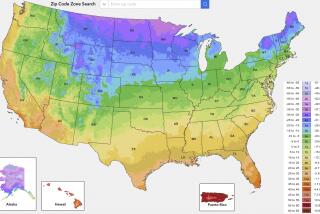Strategies for Safeguarding Flora From Frost or Freeze
- Share via
Everyone is talking about the cold weather, but it’s a particularly hot topic among gardeners. This has been a cold winter, though not one of the coldest on record. Killer frosts, however, often come later--in February or even early March.
The most common lament is about impatiens and begonias, which died back in December. In fact, both should be grown as annual plants and aren’t really supposed to survive winter. We’ve had so many mild winters it’s now taken for granted that these two shade-loving flowers will live year-round.
But many other plants, from bougainvillea to the exotic Eupatorium , have also been frosted in various parts of town. For these, it is important that you do nothing at the moment. Don’t prune or attempt to revive them, and be careful not to overwater.
Most plants will probably survive, but you won’t know for sure until spring. In late March or April, when they begin to resprout, prune off damaged wood that shows no growth. If there is no sign of recovery by late April, you have lost it and should replant at that time.
Pruning sooner will only encourage the plant to start growing again and that new growth is particularly vulnerable to frost of any kind.
Protection From Frost
A good gardener learns to expect frosts and has a plan of action ready. Killing frosts usually occur right after a storm, but not while the wind is blowing. The real cold descends when the wind stops.
Cold air is much like water in that it seeks the lowest spot in the garden. If you garden on a slope, the cold will roll to the very bottom. If it encounters a fence or other obstruction, it will become impounded, just like water, and damage any plants in the area.
For this same reason, plants that are low to the ground are more likely to be damaged than taller ones. Plants just outside the eaves of the house are likely to be damaged from the cold air rolling off the roof. In my garden, for instance, two hydrangeas not protected by the house’s eaves had their buds burned, while a third just under the eaves was unscathed.
Under the eaves is, in fact, a good place to put plants likely to suffer frost damage. Especially good is the south wall of the house where warmth from the day may last into the night. A patio roof or even a tree is usually enough to protect tender things like cactus, bromeliads and orchids from light frosts.
Weather-Only Radio
How do you know when the cold is coming? Weather forecasts often include agricultural frost warnings, one good source. For those who want to be even more certain, try the weather radio sold by Radio Shack (about $20). It’s permanently tuned to the national weather service stations which broadcast frost warnings on a regular basis.
The next best thing is to watch the pattern of the weather. If it’s been cold and the air suddenly becomes very still, be prepared. Cover large plants that cannot be moved. Old sheets are my preference, though plastic sheeting works fine. Make sure to take the plastic off the moment the sun comes up, or you risk cooking the plant. An old sheet can be left on longer with no ill effects. (You don’t have to worry about the wind blowing these coverings off because if there’s wind, there won’t be hard frost. That’s why citrus growers use big wind machines--if they keep the air moving, it won’t get as cold.)
A Source for Flax
We have turned up two sources for the spectacular yellow flax Reinwardtia indica mentioned several weeks ago. This bushy perennial is covered with yellow flowers at this very moment--in the dead of winter. One source is the Huntington Botanic Garden; the other is Hawthorne Nursery, 4519 W. El Segundo Blvd., Hawthorne; (213) 676-8242.






